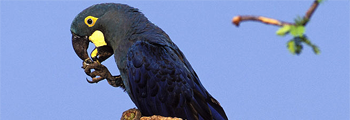This is one of the only two nesting sites for the Endangered Lear’s Macaw (AZE - since the two populations intermingle). Further, the site contains about 80 percent of the world’s population of this species. Thanks to conservation measures, the known global population of the macaw has increased approximately tenfold to more than 1,200 since the nesting grounds were discovered and patrols to reduce macaw poaching were begun.

Red and blue is a great color combination. A flock of a hundred big, deep blue Lear's Macaws perched on their red sandstone nesting cliffs is an even better combination. The cliffs at Canudos Biological Station, where about 80 percent of the world's population of the macaws nests and roosts, are spectacular in their own right.

The deep red sandstone canyons have weathered into striking, odd forms, clothed in caatinga scrub. Add to the scene, then, a band of solid indigo macaws, not quite the world's largest but near it, and the scene is enchanting. The macaws scream from their roosts before dawn, and begin to circle and visit to chat with their friends and family in the early light, their calls beating against the vaulty heaven high over our heads.
Contact us for more info
|